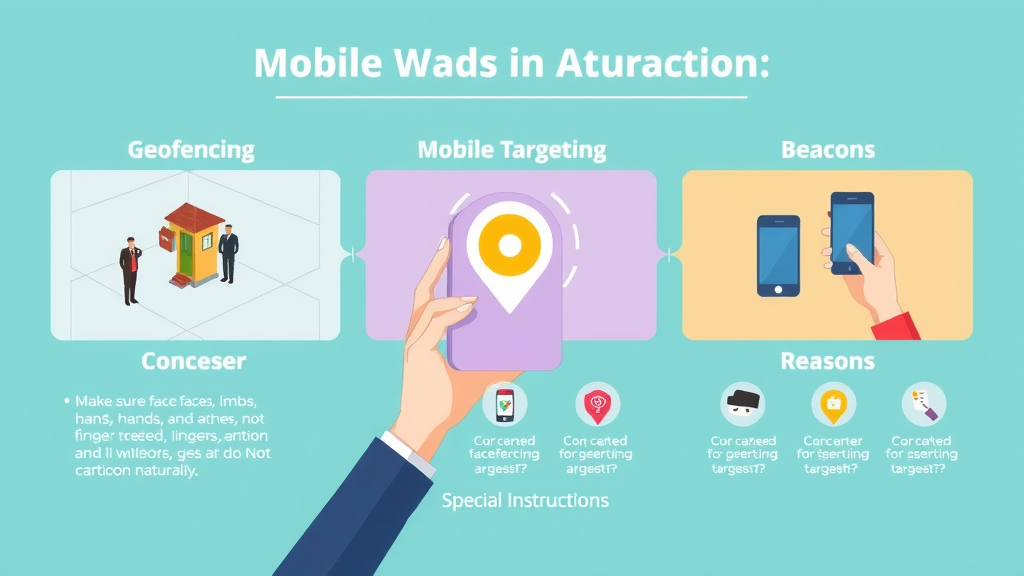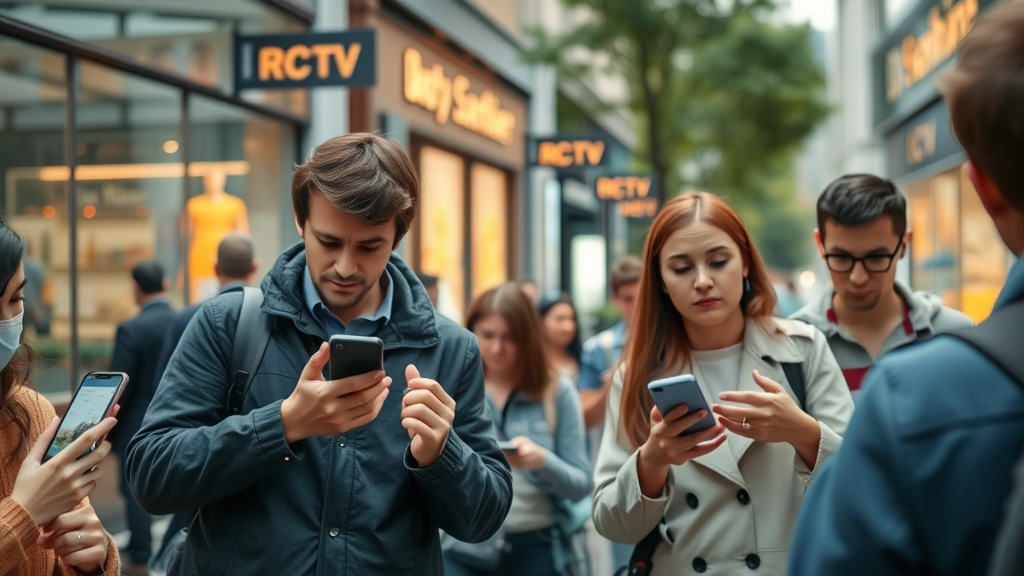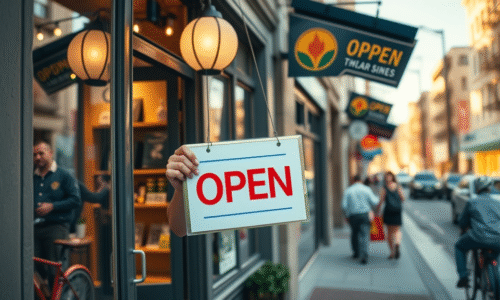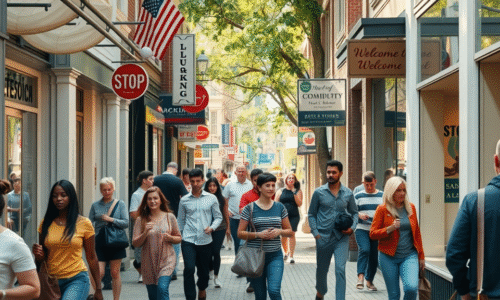Don’t Miss Out on Location-Based Marketing Power!

Did you know that businesses using location-based marketing see an average of 45% higher ROI compared to those relying only on traditional digital ads? As modern consumers spend more time on mobile devices and demand personalized, relevant content, location-based marketing (LBM) isn’t just a trend—it’s a game-changer. In this comprehensive guide, you’ll discover how LBM boosts brand awareness, drives foot traffic , enhances the customer experience , and delivers measurable ROI. Ready to capture nearby customers and grow your business faster? Read on to learn actionable strategies that can set your brand apart.
Surprising Industry Growth: Why Location-Based Marketing Is the Future of Personalized Advertising
“In 2023, businesses using location-based marketing saw a 45% higher ROI compared to those using traditional digital campaigns.”
- Gain early-mover advantage with advanced targeting that competitors can’t match.
- Increase brand awareness and engagement with customers based on their location.
- Drive more foot traffic and higher conversion rates at your physical location or retail store.
- Enhance customer loyalty by offering hyper-personalized experiences and real-time promotions.

As businesses race to capture tech-savvy consumers, location-based marketing stands out for its proven effectiveness and scalability. With advancements in mobile marketing and location data technology, both local shops and large chains now target the right audience at the exact moment they’re most receptive. Adopting LBM doesn’t just boost results—it can fundamentally shift how you approach digital, content-based, and physical advertising for years to come.
Location-Based Marketing Essentials: Defining the Strategy and Its Core Principles
What do you mean by location-based marketing?
- Location-based marketing is a targeted marketing strategy that delivers content, ads, and offers to users based on their geographic location in real time.
- Core components include mobile apps, GPS signals, mobile devices , IoT data, and location targeting via Wi-Fi or beacons.
- LBM evolved rapidly—going from SMS alerts tied to zip codes to sophisticated mobile app push notifications delivered the instant a customer enters a specific location .
This approach enables brands to reach their target audience with relevant content when and where it matters most—turning idle foot traffic into active shoppers and boosting customer engagement . Brands use LBM to customize the customer journey, tie offline and online experiences together, and support other marketing strategies like social media campaigns with hyper-local data.
What is place based marketing?
Place-based marketing is a form of LBM that focuses on reaching audiences in specific, physical locations —like airports, shopping malls, gyms, or stadiums—often through digital billboards, on-premises screens, or mobile apps that trigger promotions based on proximity. While closely related, place-based marketing emphasizes contextual engagement at the venue itself, making it a powerful tool for event marketers, retail stores, and hospitality brands aiming to maximize impact where customers are already gathering.
Types of Location-Based Marketing: From Proximity Marketing to Beacon Technology
- Geofencing: Triggers messages or ads when a mobile device enters or exits a virtual perimeter around a point of interest (store, event).
- Proximity Marketing: Sends content or offers to customers when they are physically near a location or product display, often using Bluetooth or Wi-Fi signals.
- Beacon Technology: Small devices transmit signals that enable push notifications to mobile apps when a user is in close range, driving marketing campaign conversions.
- Mobile Ad Targeting: Uses location and behavioral data to show personalized ads to users on their mobile devices based on where they are or have recently visited.
- Mobile Marketing: Ties in with location data for more targeted content flows in-app or through SMS, email, or push notifications.
| Type | Ideal Use Case | Key Advantages |
|---|---|---|
| Geofencing | Retail promotions near stores, real-time traffic alerts | High relevance, broad user reach, triggers based on movement |
| Proximity Marketing | In-store offers, event engagement, museum guides | Immediate engagement, improved conversion rates, detailed analytics |
| Beacon Technology | Personalized in-store notifications, seamless mobile check-in | Highly targeted, enhances customer experience , integrates with mobile apps |
| Mobile Ad Targeting | Localized digital campaigns, retargeting ads | Increased ad spend efficiency, hyper-local targeting, real-time updates |

Harnessing Location Data for Powerful Location-Based Marketing Campaigns
- Modern LBM collects location data through GPS signals, Wi-Fi triangulation, mobile app integrations, and IoT devices.
- Smartphones and mobile apps play a crucial role by providing in-the-moment data for precise targeting and engagement.
- Integrated platforms can source historical and real-time data to better predict foot traffic and personalize campaigns.
The role of mobile marketing and mobile apps
With mobile devices in almost every pocket, mobile marketing is inseparable from LBM. Mobile apps empower brands to send real-time push notifications when users enter predefined areas, while also collecting valuable location data to refine targeting. This two-way flow ensures users receive offers they care about, and allows marketers to analyze which geographies perform best—boosting marketing campaign ROI and keeping your brand front-of-mind at key moments. Effective mobile marketing strategies pair LBM with loyalty rewards, SMS reminders, and in-app messages to deepen customer engagement .
What is an example of location in marketing?
Imagine a coffee shop that sends a push notification with a half-price drink offer when a user walks by at 8 am, driving spontaneous purchases. Or a sports retailer that targets fans attending a nearby stadium event with mobile ads for team merchandise. These examples highlight LBM’s core value: sending the right message, to the right person, in the right place—boosting conversion rates and making the customer journey more personal and relevant.
“Data-driven location based marketing campaigns convert 2x more than generic digital ads.”
beacon technology and proximity marketing for conversion
Beacon technology is revolutionizing proximity marketing by transmitting Bluetooth signals that interact with mobile devices when customers are physically close. Retailers can push exclusive coupons to shoppers as they approach an aisle or alert visitors to new stock the moment they walk in. By integrating beacon technology with your mobile app , you can deliver timely, content-based offers that encourage immediate action, driving impulse purchases and maximizing in-store foot traffic .

Building Effective Marketing Campaigns with Location-Based Marketing
- Identify your target audience and business objectives for location-based approaches.
- Choose the right mix of marketing strategies (geofencing, beacons, mobile ads) for your market.
- Align offers and messages with local preferences and historical location data to boost relevance.
- Craft mobile-friendly content and test push notifications for engagement.
- Launch and monitor marketing campaigns —refining your approach based on analytics and customer feedback.
Aligning marketing strategies with local audiences through location data
Successful LBM campaigns depend on leveraging accurate location data to find and engage the audiences most likely to convert. By segmenting offers according to local trends, time of day, or proximity to competitors, brands deliver a customer experience that feels personal and timely. Retailers, restaurants, and event promoters are using hyperlocal analytics to optimize ad spend and ensure every dollar moves foot traffic or boosts in-store sales.
Integrating location marketing with social media and mobile marketing platforms
LBM’s most effective strategies integrate with social media and mobile marketing channels for rich, omnichannel conversations. Restaurants can launch geotargeted Instagram ads featuring real-time specials to nearby users, while retailers trigger Twitter or Facebook posts when a user enters a shopping district. Syncing mobile ads, push notifications, and social media creates a seamless journey—bringing physical and digital worlds together for your customers based on their location. By leveraging these synergies, you boost reach, engagement, and loyalty in ways traditional content based campaigns rarely achieve.

Maximizing Customer Experience: Personalization Through Location-Based Marketing
- Send tailored promotions and offers triggered by real-time location, making each interaction unique.
- Deliver relevant content that improves shopping journeys, supports decision-making, and increases satisfaction.
- Drive immediate foot traffic and build brand reputation through memorable, personalized experiences.
Leveraging customer experience insights to improve satisfaction and loyalty
LBM is a powerhouse for customer experience personalization. By analyzing shopping habits, locations, and preferred marketing channels , marketers craft bespoke offers that bridge online and offline touchpoints. For instance, a clothing store can prompt a loyal customer to check out new arrivals the moment they’re nearby, or a restaurant can thank a returning guest with a personalized discount. These real-time gestures strengthen emotional connections and lifetimes value—key goals for any marketing strategy .

Privacy Concerns with Location-Based Marketing: Ensuring Transparency & Trust
Key privacy concerns when using location-based marketing and mobile data
While LBM is powerful, it raises essential privacy concerns —users expect transparency and control over their location data . Brands must proactively communicate why data is being collected, how it’s being used, and what safeguards are in place. Ensuring users consent to push notifications and geolocation is paramount to building trust and complying with regulations.
- Always obtain explicit consent for data collection via mobile app permissions or website banners.
- Clearly describe data use in privacy policies and keep all processes compliant with regional law, like GDPR or CCPA.
- Allow users to easily opt-out or adjust location sharing settings at any time.
“Respecting privacy is essential for future-proof location-based marketing strategies.”
| Region | Regulation | User Rights | Brand Responsibilities |
|---|---|---|---|
| EU | GDPR | Consent, data portability, deletion, access | Obtain explicit consent, full transparency, data minimization |
| California (US) | CCPA | Opt-out, disclosure, data deletion, no discrimination | Enable opt-out, inform users, secure data |
| Canada | PIPEDA | Obtain consent, access, challenge accuracy | Transparent policies, secure handling, allow review |

Location-Based Marketing Performance: Analyzing and Optimizing Your Results
- Track ROI by comparing foot traffic , sales, and app engagement rates before and after LBM campaigns.
- Use analytics to refine targeting, messaging, and timing for continuous improvement.
- Integrate feedback loops to adjust offers, reduce audience fatigue , and maximize campaign effectiveness.
Tools and technologies for tracking location data and customer engagement
Platforms like Google Analytics, Facebook Business Manager, and specialized LBM solutions measure everything from push notification response rates to in-store conversions. Many tools provide heatmaps showing dwell times and customer flow by physical location , helping brands understand not just if, but how, marketing efforts are moving the needle. By tracking KPIs such as conversion rates, click-throughs, and store walk-ins, businesses continuously optimize their based marketing approach for the strongest ROI.
What are the advantages of location-based advertising?
- Hyper-targeted reach: Deliver messages to customers when and where it’s most relevant, boosting conversion rates and brand awareness .
- Real-time engagement: Trigger offers as customers enter your area or browse near your shop, increasing immediate responses.
- Measurable ROI: Directly attribute campaigns to foot traffic, redemptions, and sales.
- Personalized experiences: Increase loyalty by providing offers and content tailored to each user’s specific location and behavior.

Innovative Marketing Strategies: Combining Location-Based and Mobile Marketing
- Integrate location-based targeting into broader marketing strategies including mobile marketing , social media , and email.
- Coordinate digital, physical, and in-app content for cohesive, omnichannel engagement.
- Test creative approaches: flash deals, loyalty triggers, and event-based notifications.
Marketing campaigns that blend digital, physical, and location-based approaches
Today’s top marketers blend offline and online touchpoints for maximum impact. A fitness brand might combine in-store beacons, Snapchat geofilters, and mobile push notifications to drive event attendance. A quick-service restaurant could retarget Instagram users who’ve been near its locations with coupon codes. Combining LBM with mainstream marketing channels provides full-funnel influence—from driving awareness to converting a sale and re-engaging lapsed customers.
Getting Started: Actionable Steps to Implement Location-Based Marketing for Your Business
- Assess your current marketing campaigns and digital presence.
- Set clear objectives: boost foot traffic , expand your reach, or grow your list of app users.
- Choose location technology: geofencing, beacons, or mobile ad partners based on business size and needs.
- Build and test targeted offers, push notifications, and in-app messages.
- Measure results, refine strategy, and scale successful tactics across locations.
Selecting platforms, tools, and measuring early wins in foot traffic and conversions
Start with pilot campaigns in one or two physical locations and use cost-effective tech like Google Maps API, Facebook’s local awareness ads, or an off-the-shelf beacon kit. Focus on simple KPIs—offer redemptions, app downloads, increases in foot traffic —to prove value early, then scale what works. Many small businesses see measurable impact within weeks when they combine LBM with pre-existing mobile marketing or social media strategies.
Types of location-based marketing and their fit for different business sizes
Small retailers may prioritize geofencing for walk-by traffic, while large chains invest in advanced beacon installations and cross-platform data analytics. Food trucks, service businesses, and local event promoters find value in mobile ad targeting or partnering with location-driven apps. Large enterprises may run multi-layered strategies mixing SMS, push notifications, place-based media, and app rewards. No matter your size, there’s a fit-for-purpose LBM solution to amplify engagement and ROI.

Location-Based vs. Location Marketing: Clearing Up the Differences
- Location-based marketing: Digital targeting of users via GPS, Wi-Fi, and mobile app signals, based on current or historical geographic data.
- Location marketing: Broad strategies that boost business visibility in target areas—like optimizing Google My Business, running local SEO, or event sponsorship.
- Place-based variations: On-premises or OOH advertising (billboards, digital screens, venue targeting) delivering contextual messages based on the location of the display—and ideally, tying in digital follow-up.
“The best campaigns use both local and location data for unparalleled relevance.”
Best Practices for Proximity Marketing and Beacon Technology
- Always test beacons and Wi-Fi triggers before wide rollout to avoid notification overload.
- Provide clear value—personalized offers, relevant content, or exclusive access—to maximize user opt-ins.
- Monitor response rates and adjust message frequency to prevent audience fatigue .
- Pair beacon technology with SMS or in-app rewards to drive both immediate and long-term engagement.
- Ensure all communications are compliant with local privacy regulations.
Case Studies: Real-World Success with Location-Based Marketing
- Retail Giant: Increased foot traffic by 35% during holiday weekends by sending timely push notifications to nearby shoppers, resulting in a 25% spike in sales.
- Restaurant Chain: Used beacons and mobile apps to reward repeat customers, achieving 2x higher coupon redemption rates and building brand loyalty.
- Music Festival: Delivered custom SMS and in-app offers to festival-goers, driving vendor sales and deepening engagement with sponsors.
Mobile marketing campaigns and measurable outcomes
Location-based mobile marketing generates impressive results across sectors. Fast-casual eateries use lunchtime geofencing to capture impulse diners, while clothing chains deploy app-driven offers for in-store exclusives. These marketing campaigns measure their success via increased store check-ins, higher order values, and improved customer retention—helping marketers prove the return on LBM investments.

Avoiding Pitfalls: Common Challenges with Location-Based Marketing
- Accuracy: GPS, Wi-Fi, and beacon signals may vary—test thoroughly before rollout.
- Privacy: Always get users’ permission before collecting location data and follow best practices for transparency.
- Audience Fatigue: Avoid over-notification by segmenting your audience and capping daily message sends.
- Data Integration: Use a central dashboard to monitor and analyze all campaign activity from different channels.
Solutions for overcoming location data and technology issues
- Partner with reputable providers to ensure robust signal quality.
- Schedule notifications during peak business hours for higher engagement.
- Offer opt-ins for notification categories—reward loyal users without annoying casual browsers.
- Deploy automated analytics to catch issues early and refine your marketing strategy in real time.
- Maintain a checklist for continuous monitoring and iterative improvement of LBM performance.
People Also Ask: Answers to Your Top Location-Based Marketing Questions
What do you mean by location-based marketing?
Location-based marketing is a strategy where brands use a person’s current or historical physical location, gathered through GPS, mobile apps, Wi-Fi, or beacons, to offer personalized content, promotions, and ads. It helps businesses engage customers with the right message at the precise moment and place they’re most likely to act—boosting conversion and relevance.
What is place based marketing?
Place-based marketing refers to delivering marketing messages at specific venues (such as airports, gyms, or shopping malls) often using digital screens, mobile ads, or event sponsorship. While similar to LBM, it usually focuses on audiences located within a particular venue and often blends digital and physical advertising methods for contextual impact.
What is an example of location in marketing?
A classic example is a sports apparel store geofencing local stadiums on game days, sending fans in that area a push notification for a special promotion. Another is a restaurant sending lunchtime deals to office workers nearby, driving immediate walk-ins.
What are the advantages of location-based advertising?
Location-based advertising allows brands to reach hyper-targeted audiences, deliver real-time and highly relevant offers, increase measurable foot traffic, and boost customer engagement—all while maintaining a clear link between campaign spend and sales outcomes.
FAQs About Location-Based Marketing
- Q: How much does location-based marketing cost? A: Costs depend on your strategies (e.g., mobile ads vs. beacons), reach, campaign complexity, and technology partners. Some platforms start at a few hundred dollars for small tests, but costs rise for regional or multi-channel campaigns.
- Q: What industries benefit most from location marketing? A: Retail, restaurants, hospitality, events, automotive, and service businesses gain the most—especially those with physical locations and high competition for local attention.
- Q: How does beacon technology work in-store? A: Beacons emit Bluetooth signals detected by your app, automating personalized notifications or offers when customers are nearby—boosting dwell time, engagement, and conversion rates.
- Q: How can I ensure user privacy with location campaigns? A: Always get clear user consent, explain data usage, let users manage location-sharing settings, and stay compliant with privacy laws like GDPR or CCPA.
Key Insights: Why Location-Based Marketing Should Be Your Next Marketing Channel
- Proven ROI: LBM outperforms traditional digital campaigns in both engagement and conversion.
- Personalized customer experience: Offers tailored to real-time user location and behavior boost loyalty.
- Future-ready compliance: Stay ahead of evolving privacy laws with transparent practices and robust opt-ins.
- Omnichannel power: Effective LBM connects mobile, in-store, and digital worlds for seamless audience journeys.
- Scalable strategies: Fits businesses of all sizes, industries, and goals—whether brick-and-mortar or hybrid.
Ready to Grow Your Local Reach?
Want help applying these strategies to your business? Book your free strategy call now , and get clear, practical steps to grow your local reach fast!
Location-based marketing (LBM) is a transformative strategy that enables businesses to deliver personalized content and offers to consumers based on their real-time geographic location. This approach leverages technologies such as GPS, Wi-Fi, and mobile apps to engage customers with relevant messages precisely when and where they are most likely to act.
Key Benefits of Location-Based Marketing:
-
Enhanced Targeting Precision: By utilizing geographical data, businesses can present content to the right audience at optimal moments in their purchasing journey. For instance, a retailer can send promotions to consumers within a specific radius, increasing the likelihood of conversion. ( mountain.com )
-
Increased Relevance and Personalization: LBM allows for the delivery of highly relevant content tailored to a user’s location, enhancing the customer experience and fostering deeper engagement. Personalized offers based on real-time location data can significantly improve customer satisfaction and loyalty. ( adjust.com )
-
Improved Customer Engagement: By providing content that reflects consumers’ real-world surroundings, LBM fosters more engaging and memorable interactions with the brand. This relevance leads to higher engagement rates and strengthens the customer-brand relationship. ( mountain.com )
-
Higher Conversion Rates: Targeted location-based campaigns often result in higher conversion rates due to the relevance and timeliness of the offers. Consumers are more likely to act on promotions received when they are in proximity to a store or ready to make a purchase. ( geoplugin.com )
-
Valuable Customer Insights: LBM provides businesses with real-time data on consumer behavior, preferences, and movement patterns. These insights enable companies to refine their marketing strategies, optimize resource allocation, and make data-driven decisions to enhance overall performance. ( geoplugin.com )
-
Cost-Effective Advertising: By focusing marketing efforts on specific geographic areas, businesses can optimize their advertising spend, reducing waste and increasing efficiency. This targeted approach ensures that marketing resources are directed toward audiences most likely to convert. ( darwill.com )
Implementing Location-Based Marketing:
To effectively implement LBM, businesses should:
-
Identify Target Audience and Objectives: Clearly define the demographic and geographic segments to target and establish specific goals for the campaign.
-
Choose Appropriate Technologies: Select the right mix of LBM strategies, such as geofencing, beacons, or mobile ad targeting, based on business needs and customer behavior.
-
Develop Relevant Content: Craft personalized offers and messages that align with local preferences and real-time data to enhance relevance and engagement.
-
Monitor and Optimize Campaigns: Continuously track campaign performance using analytics tools to measure success and make data-driven adjustments for improvement.
By embracing location-based marketing, businesses can unlock unparalleled targeting capabilities, drive foot traffic, enhance customer experiences, and achieve measurable returns on investment.





